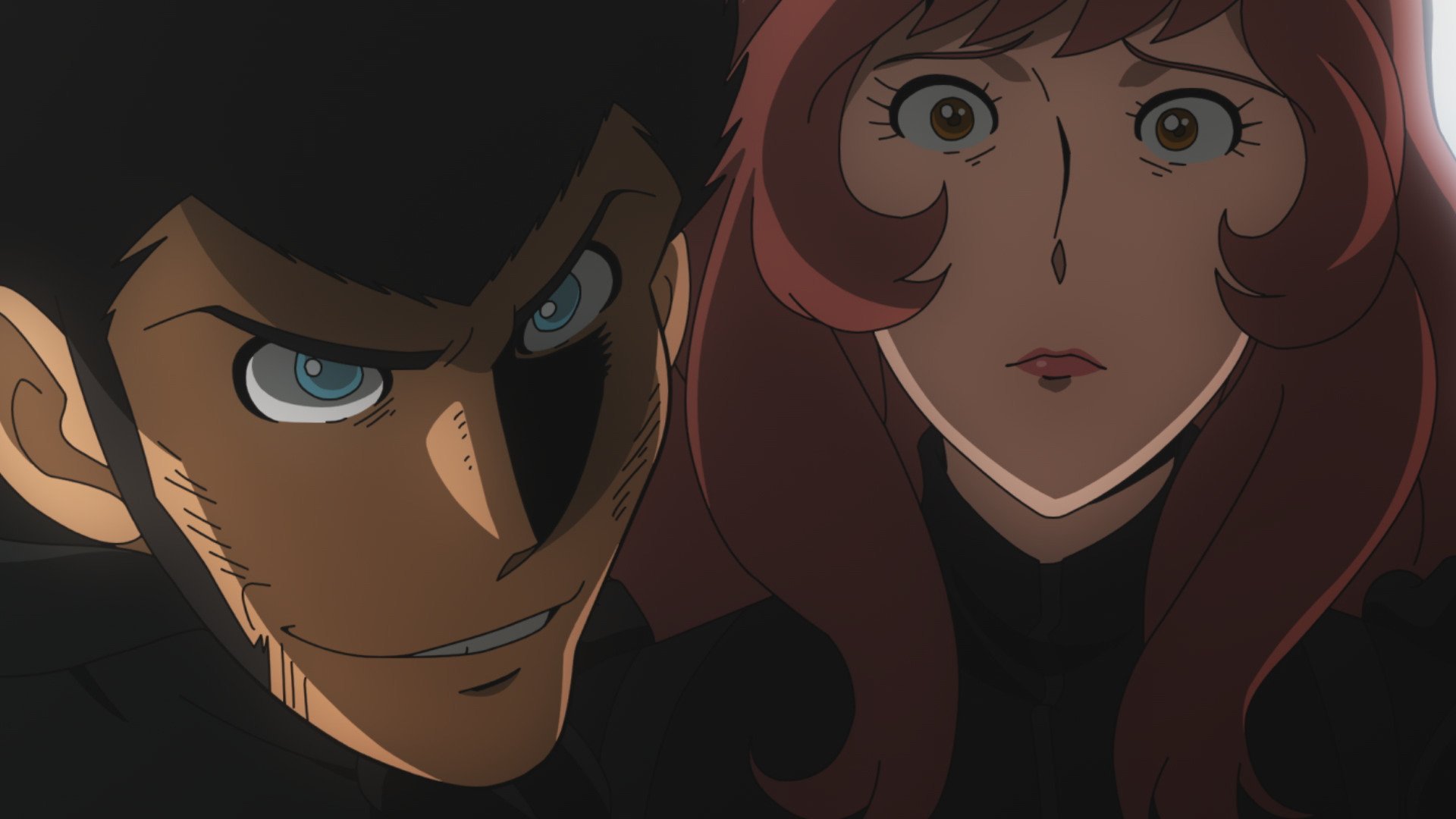Review: Part 6 “Final Thoughts”
Be aware that there are SPOILERS ahead.
Please only read on if you either have seen the entirety of Lupin III: Part 6 already, or do not mind learning about important character interactions and pivotal plot points in advance.
Estimated average read time is 15 – 20 minutes.
Lupin III is a franchise that I have held near and dear to me since I first became introduced to Part 2 back in the late noughties.
While all of its dressing tends to impress—the often superb, varied animation, the classy music, the blood-pumping chase sequences—it is the characters that keep pulling me back into the world of Lupin. The dynamic between the core five group members never fails to entertain, and the breadth of stories the writers have told over the years, revolving around their relationships, and individual personalities, is awe-inspiring.
Naturally, over the course of the series’ lengthy fifty year run, there have been plenty of ups and downs.
The Woman Called Fujiko Mine shocked me at first, with its radical change in tone. Over the course of its thirteen episode run, I became accustomed to it, which resulted in me loving the show.
While I went into 2015’s Part 4 with high expectations, I felt let down slightly by the over-arcing plot (although I adored the one-shot story episodes, the animation, and the music tracks, which all remain some of my favourite in the franchise to date). The da Vinci character had me rolling my eyes, and a couple of the latter story episodes left me feeling bored.
Part 5 gave me the opposite—I enjoyed the over-arcing plot, despite a few niggles with Ami’s portrayal, and her relationship with Lupin. Its integration of modern-day technology was clever, and the way each member of the gang reacted to it was fun to watch. I felt the one-shot story episodes, however, were a tad weak, and inconsistent in their quality.
The latest series, which is split into two core “acts”, with one-shot storylines peppered in-between, celebrates the first television series and the animated show’s fiftieth anniversary. A dynamic show-down between Lupin and Holmes, the return of the green jacket, an adventure in London. At least, this is what the marketing build up, back in fall 2021, led us to believe.
It turned out, that not everything promised here was true.
The Lupin versus Holmes arc only lasted for six episodes, and ended before the series hit its half-way mark. Unfortunately, Holmes himself felt underused, and his story, while shrouded in darkness and mystery, wrapped up in a predictable and underwhelming manner. There was a very minor scuffle between both Lupin and Holmes, which was rather underwhelming considering the build-up of the marketing, and the climax of episode two. There had been no real villain, no real treasure, and no interesting conclusion.
The arc simply left us with many loose ends, and swiftly moved on without any real sense of satisfaction.
Could it be, then, that the one-shot episodes were to pick up the slack, where the Holmes story let us down?
I felt this was mostly the case. The first half of the show featured some rather creative throwbacks to classic crime fiction, referencing the works of Edogawa Ranpo, Ernest Hemingway, and more. Other than Mamoru Oshii’s The Killers in the Diner episode, which I disliked at the time and still do, for its poor dialogue and “look at me, I have a big brain” style of storytelling, I felt that most of the other one-shots were fun.
Perhaps, at the time, in my reviews, I had been a little too harsh on them.
Taku Ashibe's two-parter, The Imperial City Dreams of Thieves, particularly stands out amongst the rest. These episodes threw Lupin back in time, an idea that only the likes of the rather dire Elusiveness of the Fog had explored previously. Thankfully, Ashibe and the team do a much better job here, with plenty of fun character moments and hi-jinks that are sure to entertain. The femme fatale, Black Lizard, was a favourite of mine—I only wish we had seen more of her, and less of Ms. Ruriko and her “partner”, Miss. Sarantuya. A flawed, but solid trip into the past, and the works of Edogawa Ranpo.
Akio Higuchi’s “Last Bullet”, which features a narrative related to the Lupin III VS Sherlock Holmes storyline, is another personal highlight. It is a far cry from The Combat Magnum Scattered in the Wasteland, a fun, quirky Part 2 tale focusing on Jigen, but it still provided some excellent moments for the hatted gunman. It was great to see the crew visiting my homeland of Scotland, too, however the loose end of Kenny still baffles and humours me.
Despite mugging him off a couple of paragraphs ago, Mamoru Oshii’s second episode fared far better with me, and it remains my favourite episode from Part 6. Darwin’s Bird has a rather uncomfortable tone running throughout, and it successfully executes a weird, “out-there” storyline without feeling out of place. While the topic of palaeontology and religion may rub some the wrong way, it puts a new, interesting spin on the characters we love so dearly, and the jobs they take on. There is a moment in particular that stands out to me, that involves the gang discussing said job in a nearby forest. The dialogue here between Fujiko, Lupin and Jigen felt fantastic. It was almost like being granted a “backstage pass” into seeing how the trio plan for a heist, and Jigen’s grumpy exit after stating he did not trust Fujiko’s employer was spot on. Oshii nailed the characters here—something I feel he failed to do with The Killers in the Diner.
This is one to watch, even if you feel that you must skip all episodes that precede it. I cannot wait to hear how it sounds in English dub form, once it airs on Toonami in the United States.
The second act, then, saw a shift in staff, as well as in story. In addition to a brand-new line-up of guest-writers, including Tomoko Shinozuka, Ayumi Shimo, and Kōichi Chigira, Shigeru Murakoshi (ZOMBIE LAND SAGA) replaced Takahiro Okura as the lead of series composition, a change I believe was for the better.
Adopting a similar structure to the first act, the second sees Lupin facing off with Tomoe, a woman claiming to be his mother. While it also appears to have six episodes tying into this plot, surprisingly, Murakoshi finds a way to tie all the guest-written episodes into the shows’ finale. This creates a twist that did nothing but scream “you tried”, in my personal opinion, in a rather disappointing conclusion that stumbled across the finish line into mediocrity.
Thankfully, there are a lot of strong points regarding the show’s second act, and the main storyline with Tomoe. The opener is strong, with a daring jewel heist, and a formidable foe fighting with Lupin high above the streets of New York. Kanichi Kurita flexes his vocal ability to pull off both serious and goofy Lupin, and all members of the gang have a good sense of place, feeling relatively well utilized. The animation, which has been rather average throughout the entire series up until this point, looks attractive in parts here, and it genuinely feels as if Murakoshi was keen to make a good first impression.
While it eventually loses its way at the end, mostly in part due to the character’s need of over-explaining everything rather than putting on an entertaining show, the build up to Lupin’s confrontation with Tomoe, and how it affects the gang’s dynamic in episode twenty-three, is superb. We see a much darker side to Lupin, as he is put under Tomoe’s control and seeks to be by her side, no matter the cost. Next to Darwin’s Bird, The Memories of a Beloved Witch is my second favourite episode from this season for that reason. This is an excellent performance by all members of the voice cast, and the writing staff, that manage an interesting, darker spin on the characters that does not pull any punches. It is just a shame that the episode that followed did not live up to the high expectations’ episode twenty-three had left me with, and that the second act did not quite stick its landing.
Beside the Tomoe arc, the guest-written episodes were still coming in thick and fast. Unlike the first half of the season, the second ditches the crime-fiction hook, and instead focuses on individual characters. I felt these were weaker, as a result, and mostly all told tales we have seen previously, in less appealing ways. The Jigen episode in particular, Akira Kindaichi's Wedding Bells Ring with the Sound Of Gunfire, was so bog-standard, I had hardly anything to say about it in the episode review.
Tomoko Shinozuka's Samurai Collection was better, injecting some much-needed humour into the show, at that point. Seeing Goemon star in a fashion show was a fun little aside, that will no doubt please the samurai’s many fans. Akira Kindaichi’s second attempt, however, Win or Lose in 0.1 Seconds, will no doubt be considered a classic. This ditches any “big brain” narrative and over explanations of the plot, for a more contained, Part 2 feeling tale. The team infiltrate a security complex in a way that only Lupin can do, with the core cast working together, bickering away, and beating impossible odds to reach their goal (in unexpected ways, of course)! I would bet that when many viewers think of Lupin, they think of stories and episodes like this. For me, it remains another personal highlight, and is one to watch alongside Darwin’s Bird.
Looking back across Part 6, despite its redeeming qualities, something certainly feels off. Despite my ups and downs with all the series previously mentioned, and also of those further back across the shows’ history, this latest entry left me with a different feeling. I felt this all came down to a couple of things; characters and pacing.
The beauty of Lupin and its characters, its writing, is its ability to tell interesting stories. Continuity and consistency, in terms of plot, is not something that ever concerns me. I am more than happy to spend an episode watching the gang embark on a spooky adventure into Dracula’s Castle, then spend the next figuring out how to pilfer some Bitcoin from an online bank. This versatility is something I appreciate from the show—but with Part 6, the issue was not solely in the stories themselves, but in the show’s composition.
Part 5 managed to nail its overall pacing and structure, by spreading out longer, more involved storylines in four or five episode chunks, bookended with a pattering of guest-written adventures. Part 6, however, decides to mix things up more. Those five episode story chunks still do exist, but rather than playing alongside one another, they are split up and mixed in amongst the side content. This made the two act narrative hard to follow, especially when you consider that all the story episodes rely on knowledge of the ones that proceed. Watching on a weekly basis made this hard to comprehend, and at times, I can see many of the twists and reveals going over the viewer’s head, as a result of this.
Regarding the characters—while the main gang had some shining moments across the series’ run, there were a few that felt lacklustre. We were treated to fun screen time from Inspector Zenigata’s assistants, “Yata” and “Ari”, but it felt as if the tough cop himself was done dirty this season. In the majority of his act one scenes, he simply felt present as a means of existing, reminding the viewer that he is there. He does little to contribute, and this felt like a huge missed opportunity. One episode in particular, An Untold Tale, even goes as far as to show him sleeping on the job, failing to confront his target. In my opinion, this is a cardinal sin—in Lupin terms, of course. It shows a misunderstanding and misuse of the character. Everything I love about Zenigata was absent from this episode, which left me disappointed. While things improved during the second act, it felt as if he only poked his head up slightly—as opposed to stealing the show, as he often does.
There is also the curious case of Albert d'Andrésy, a major character of Part 5, who seemed a fan favourite at the time. Part 5 almost felt like a prime set-up for Part 6, where Albert and Lupin’s family lineage is concerned. Instead, he only appeared throughout the first act, to get shot, near off himself, and throw petty threats at Lupin. Again, he felt underused, and his presence only muddied what was already a rather murky story situation. I do hope we see more of him in the future, but through the lens of someone exploring his origin, his relationship to Lupin, and his purpose within the show. I cannot believe we made it through Part 6 knowing nothing more about him.
Many of the new cast during act one felt lacklustre—especially poor Lily Watson, who spent a solid chunk of the first act taken ill, and in bed. Lestrade came across as a predictable villain, and I cared very little for the FBI agents, and “The Raven”. The second act stepped things up majorly in this department, at least for the bulk of its existence. Tomoe, while not quite related by blood, served as a unique and fascinating villain. Mercedes provided some stellar action sequences, and the one-shot women were mostly all fun to meet. With that said, it is hard to overlook the disappointment that act one brought to the table when assessing the series as a whole.
I came to realize during my watch of Part 6, that the show just might not be for me.
Enough people have enjoyed the new characters, setting, and two act structure to warrant some celebration. I could never personally recommend the show, but I would not want to put someone off watching it. What I consider the weakest series to date, might be someone else’s favourite, and that is an idea to cherish. This series, in general, has the uncanny ability to pander to so many people’s different tastes, not each new entry will please everyone.
It is absolutely worth giving Part 6 a try, and for you to make your own mind up on its sporadic story, its varied guest-written episodes, and everything else it has to offer.
I must give a quick shout-out to episode zero, which I feel is often forgotten in the grand scheme of things. While this came across more like an episode of Part 5 than Part 6, it provided a memorable send-off for Kiyoshi Kobayashi, who had announced his retirement prior to the episode’s air date. The writing showed some promise of exploring Lupin’s relationship with right-hand-man Jigen in greater depth, which, at the time, I had hoped to see more of as the series progressed. Sadly, this was not the case, but the moments we did see involving this during The Times are ones worth treasuring—just like those moments we spent listening to Kiyoshi Kobayashi himself.
Oh, and because I seemingly cannot end on a happy note—no more 3DCG car chases. As much as I can appreciate the pandemic’s effect on the animation industry, please, try to avoid this. Every instance a 3DCG vehicle was on-screen during Part 6, it felt, to me, like some of the soul of the Lupin series had been ripped away. The Fiat 500 is as prominent a character in this franchise as the gang themselves—and seeing it lifelessly slide down a road and topple over, breaks my heart.
Rest in 3DCG pieces, little yellow buddy.
Phew. That was a long one! Thank you for sticking with us, and reading our Lupin III: Part 6 content. I personally would not have stuck with the weekly episode reviews if it was not for you, dear reader, and I really appreciate all the amazing comments and feedback I have received over the past few months. You are wonderful.
Still hungry for more?
You can also check out our brand-new review hub, which links to reviews for individual Part 6 episodes, where we dive even deeper into all aspects of the show. Also, if you are in the United States, be sure to catch the first English dubbed episode on Adult Swim’s Toonami this weekend!
























